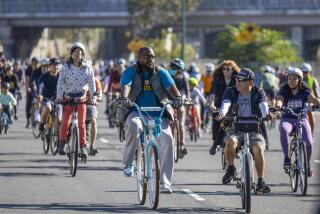It’s a Mud, Mud Mud, Mud World
- Share via
They emerged from the freezing muck carrying their cycles, exhausted and covered with mud. And they were the winners.
The 1997 cyclecross national championships were held, not despite of, but because of the rotten conditions in frigid Denver.
“We started with two to three inches of ice and snow and then the conditions went from snow to ice to mud,” said Frank Stanley of USA Cycling Inc., which sponsors the championships. “By the time the race was done, some of the riders didn’t even look human.”
Not surprisingly, the intense physical demands of cyclecross draw Orange County bikers looking for new challenges.
Cyclecross is about the course, usually a two-mile oval filled with obstacles that often force the rider to bodily carry his bicycle. The competitions are timed, which means 10 to 20 miles of pedaling, jumping and hauling--and pain.
“The winner is the one who suffers and hurts the most,” said Mark Salmon, a Fullerton bike shop owner who finished eighth in last December’s cyclecross championships. “It’s a wonderful sport.”
As with most emerging sports, there are no exact statistics on the number of participants. But Stanley said the number of competitions around the country increases every year.
Salmon, who sells cyclecross bikes and accessories, said his cyclecross sales have quadrupled in the past 12 months.
Despite signs of increasing popularity, cyclecross is relatively unknown. Riders are used to handling questions from the curious, such as, “So, what is that bike?”
To handle the twists and turns of the obstacle course, the cyclecross bicycle has taller, thinner tires than a mountain bike.
The disparity is only about an inch and a half “but it makes a big difference out on the course. You can move a lot better with the thinner tires,” Salmon said.
The frame has a low profile and is extremely lightweight because riders have to easily hop off and carry their bike, then jump back on.
“People have no idea what cyclecross is,” said Damon Roberson, a Huntington Beach resident who in January finished third in a Las Vegas elite class competition. “They go, ‘Why on earth would you want to carry your bike?’ ”
Because it’s very, very hard, cyclecrossers reply.
Top competitors such as Salmon relish the idea of pain, pushing their bodies as far as they can go.
“You just grin and bear it,” Salmon said. “The suffering is the appeal. There’s no way to explain it to someone who hasn’t been there.”
Cyclecross riders like to consider themselves a cult, bonded together by the love of the extreme.
Said Roberson, “It’s not something we do because it’s cool, it’s something we do for the effort and the excitement.”
Salmon says cyclecross is also a frame of mind.
“You see this look in people’s eyes when they’re flying down the hill and they’re smiling about it,” Salmon said. “It takes a lot of intensity, an extreme amount of focus. That’s the appeal.”
Its beginnings can be traced more than 100 years ago, when a French soldier was looking for a more efficient way to keep in shape during the winter, said Salmon, a cyclecross history buff. Word spread and soon groups of riders were joining him. By 1902, the French Cycling Federation had sanctioned the first competition.
Cyclecross continued to evolve during wartime, particularly in Europe as messengers needed to wind their way through rubble-filled streets.
The first organized cyclecross competitions spread throughout Europe during the early 1950s and the sport blossomed overseas.
“It’s far more popular over there,” Stanley said. “It’s a hard-core sport. That’s where the top cyclecross competitions are held.”
Cyclecross is a seasonal sport running from October through February. There are competitions across the country, mainly in the sport’s hot spots, which include New England, Northern California, the northwest U.S. and Colorado.
Southern California cyclecross events are usually held in San Diego and at the Olympic Velodrome at Cal State Dominguez Hills.
No events have been held in Orange County simply because nobody has stepped forward to organize a competition, Salmon said.
Even though the thermometer rarely drops below freezing locally, Salmon sees that as a competitive advantage that helped Southland riders at the 1997 nationals.
“We don’t ever get a chance to ride in the snow,” Salmon said. “We really look forward to racing in true winter conditions so we . . . did great.”


